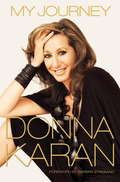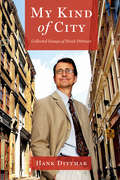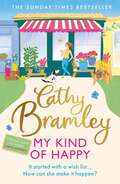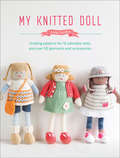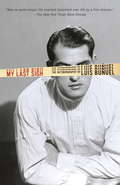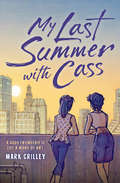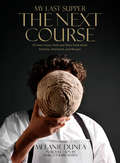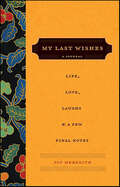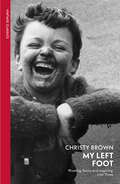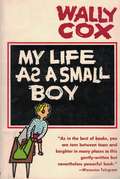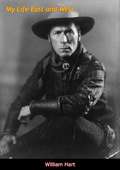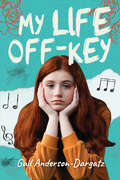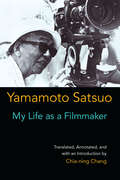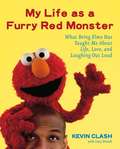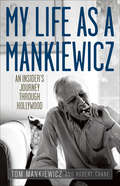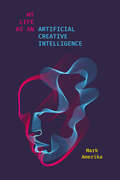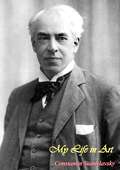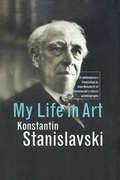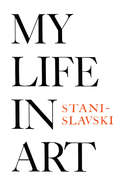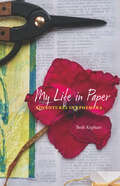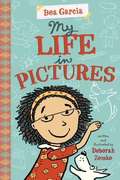- Table View
- List View
My Journey
by Donna KaranIn this candid memoir, renowned designer Donna Karan shares intimate details about her lonely childhood, her four-plus decades in the fashion industry, her two marriages, motherhood, and her ongoing quest for self-acceptance and spiritual peace. Donna Karan was born into the fashion business--her father was a tailor, and her mother was a showroom model and Seventh Avenue saleswoman--yet Karan dreamed of becoming a dancer like Martha Graham or a singer like Barbra Streisand. Fashion was her destiny, though. My Journey traces Karan's early days as an intern at Anne Klein, the creation of her Seven Easy Pieces (which forever changed the way working women dressed), and the meteoric rise of her company. Along with juicy industry stories, Karan candidly discusses her difficult mother and traumatic childhood, her turbulent romantic life, all the loved ones she has lost over the years, and the personal awakening that occurred just as she reached the height of professional and financial success. That awakening set Karan down a path of spiritual discovery and self-improvement. From est to Kabbalah, from silent retreats to leech therapy, Karan tried everything to find, as she writes, "calm in the chaos." But she also reveals how a chaotic life, fueled by endless curiosity and childlike impulses, helped her design seminal collections season after season for global powerhouse brands Donna Karan New York and DKNY. She also details how she has channeled her creativity (and her urge to solve problems and nurture others) into philanthropic work, particularly her early outspoken advocacy for AIDS awareness and research, and the creation of her Urban Zen Foundation, focusing on integrated healthcare and education as well as preservation of culture, which led to her current efforts in Haiti. Karan's life has been crowded with glamorous characters and adventures around the world. But she sometimes still feels like that awkward teen from Long Island who never fit in--which makes her all the more endearing. Brimming with Karan's infectious energy, My Journey is about much more than the fashion world: It is the story of a young woman whose vision and hard work made her a role model for women everywhere--a woman who dreamed big, fought to have it all, broke the rules, and loved passionately along the way.Advance praise for My Journey"Donna's creativity and passion as a committed philanthropist are matched only by her gift for friendship. Whether she's making the world more beautiful or giving a Haitian artisan the tools to create a sustainable business, Donna has always led with great heart and wonderful humor."--President Bill Clinton"What we take for granted often comes from the most revolutionary of sources. In New York in the 1980s, no one was more radical than Donna Karan. She created a way of dressing that was womanly, practical, and empowering."--Anna Wintour "My Journey is the story of an extraordinary personal, professional, and spiritual life. It's a journey defined by Donna's incredible resilience, her inward search for calm in the midst of success, and her insistence on always following her heart."--Arianna Huffington "Anyone who has ever watched Donna Karan in the dressing room with one of her loyal customers has witnessed a bond between designer and client that is as vital as an umbilical cord. That same bond is present on every page of this memoir."--Ingrid Sischy "Donna demonstrates unwavering passion and commitment to women, family, design and all of humanity with her immense philanthropic work. Her story is fascinating!"--Calvin KleinFrom the Hardcover edition.
My Kind of City: Collected Essays of Hank Dittmar
by Hank Dittmar"Hank lived by the credo, ‘first listen, then design'.”—Scott Bernstein, Founder and Chief Strategy + Innovation Officer, Center for Neighborhood Technology Hank Dittmar was a globally recognized urban planner, advocate, and policy advisor. He wrote extensively on a wide range of topics, including architectural criticism, community planning, and transportation policy over his long and storied career. In My Kind of City, Dittmar has organized his selected writings into ten sections with original introductions. His observations range on scale from local ("My Favorite Street: Seven Dials, Covent Garden, London”) to national ("Post Truth Architecture in the Age of Trump”) and global ("Architects are Critical to Adapting our Cities to Climate Change”). Andrés Duany writes of Hank in the book foreword, "He has continued to search for ways to engage place, community and history in order to avoid the tempting formalism of plans.” The range of topics covered in My Kind of City reflects the breadth of Dittmar's experience in working for better cities for people. Common themes emerge in the engaging prose including Dittmar's belief that improving our cities should not be left to the "experts”; his appreciation for the beautiful and the messy; and his rare combination of deep expertise and modesty. As Lynn Richards, CEO of Congress for the New Urbanism expresses in the preface, "Hank's writing is smart without being elitist, witty and poetic, succinct and often surprising.”My Kind of City captures a visionary planner's spirit, eye for beauty, and love for the places where we live.
My Kind of Happy: The new feel-good, funny novel from the Sunday Times bestseller
by Cathy BramleyIt started with a wishlist... Now can she make it happen?'A story bursting at the seams with sunshine' Milly Johnson'Filled with warmth and laughter' Carole Matthews'A delightfully uplifting, inspiring read. You might just want to change your life too' Fiona Gibson------------'I think flowers are sunshine for the soul.'Flowers have always made Fearne smile. She treasures the memories of her beloved grandmother's floristry and helping her to arrange beautiful blooms that brought such joy to their recipients.But ever since a family tragedy a year ago, Fearne has been searching for her own contentment. When a chance discovery inspires her to start a happiness wishlist, it seems that Fearne might just have found her answer...Sometimes the scariest path can be the most rewarding. So is Fearne ready to take the risk and step into the unknown? And what kind of happiness might she find if she does?Fall in love with this romantic, feel-good story from bestseller Cathy Bramley about one woman's search for happiness!My Kind of Happy was originally published as a four-part serial. This is the complete story in one package.------------Readers are LOVING My Kind of Happy!'Inspiring and uplifting' 5*'Cathy just gets better and better' 5*'Like a dose of sunshine on a dismal day...' 5*'A feel-good story!' 5*'Draws you in from the beginning...' 5*'I laughed and cried my eyes out!' 5*------------Your other favourite authors love to curl up with Cathy Bramley too:'Delightful!' Katie Fforde'A page-turner of a story' Milly Johnson'Delightfully warm with plenty of twists and turns' Trisha Ashley'The perfect romantic tale, to warm your heart and make you smile' Ali McNamara
My Kind of Happy: The new feel-good, funny novel from the Sunday Times bestseller
by Cathy BramleyIt started with a wishlist... Now can she make it happen?'A story bursting at the seams with sunshine' Milly Johnson'Filled with warmth and laughter' Carole Matthews'A delightfully uplifting, inspiring read. You might just want to change your life too' Fiona Gibson------------'I think flowers are sunshine for the soul.'Flowers have always made Fearne smile. She treasures the memories of her beloved grandmother's floristry and helping her to arrange beautiful blooms that brought such joy to their recipients.But ever since a family tragedy a year ago, Fearne has been searching for her own contentment. When a chance discovery inspires her to start a happiness wishlist, it seems that Fearne might just have found her answer...Sometimes the scariest path can be the most rewarding. So is Fearne ready to take the risk and step into the unknown? And what kind of happiness might she find if she does?Fall in love with this romantic, feel-good story from bestseller Cathy Bramley about one woman's search for happiness!My Kind of Happy was originally published as a four-part serial. This is the complete story in one package.------------Readers are LOVING My Kind of Happy!'Inspiring and uplifting' 5*'Cathy just gets better and better' 5*'Like a dose of sunshine on a dismal day...' 5*'A feel-good story!' 5*'Draws you in from the beginning...' 5*'I laughed and cried my eyes out!' 5*------------Your other favourite authors love to curl up with Cathy Bramley too:'Delightful!' Katie Fforde'A page-turner of a story' Milly Johnson'Delightfully warm with plenty of twists and turns' Trisha Ashley'The perfect romantic tale, to warm your heart and make you smile' Ali McNamara
My Kind of Transit: Rethinking Public Transportation (Center For American Places - My Kind Of ... Ser.)
by Darrin NordahlIn My Kind of Transit, Darrin Nordahl argues that like life itself, transportation isn't only about the destination, but the journey. Public transit reduces traffic and pollution, yet few of us are willing to get out of our cars and onto subways and buses. But Nordahl demonstrates that when using public transit is an enjoyable experience, tourists and commuters alike willingly hand in their keys. The trick is creating a system that isn't simply a poor imitation of the automobile, but offers its own pleasures and comforts. While a railway or bus will never achieve the quiet solitude of a personal car, it can provide, much like a well-designed public park, an inviting, communal space. My Kind of Transit is an animated tour of successful transportation systems, offering smart, commonsense analysis of what makes transit fun. Nordahl draws on examples like the iconic street cars of New Orleans and the picturesque cable cars in San Francisco, illustrating that the best transit systems are uniquely tailored to their individual cities. He also describes universal principles of good transit design. Nordahl's humanistic treatment will help planners, designers, transportation professionals, and policymakers create transit systems the public actually wants to ride. And it will introduce all readers to delightful ways of getting from point A to point B.
My Knitted Doll: Knitting Patterns for 12 Adorable Dolls and Over 50 Garments and Accessories
by Louise CrowtherCreate twelve dolls and over fifty garments and accessories to dress them in with this wonderful collection, featuring easy-to-follow instructions.Make an adorable, knitted doll for the little person in your life. Children will love all twelve dolls in this knitting pattern collection which has been designed to provide the perfect playmate.Each doll has their own personality and style—whether it’s Faye with her cute bunny ear hast and cozy boots, or Jane with her chic beret and Breton top. There is a doll here to suit everyone. The step-by-step instructions show you how to make the twelve individual dolls, but you could also mix and match the outfits, hairstyles, and colors to create the perfect doll for you.My Knitted Doll is not for the absolute beginner knitter but will appeal to knitters who do have a basic understanding of the craft. Having said that, the instructions are presented succinctly with easy-to-follow diagrams, with charts for intarsia and other designs.
My Last Sigh
by Luis BunuelA provocative memoir from Luis Buñuel, the Academy Award winning creator of some of modern cinema's most important films, from Un Chien Andalou to The Discreet Charm of the Bourgeoisie.Luis Buñuel's films have the power to shock, inspire, and reinvent our world. Now, in a memoir that carries all the surrealism and subversion of his cinema, Buñuel turns his artistic gaze inward. In swift and generous prose, Buñuel traces the surprising contours of his life, from the Good Friday drumbeats of his childhood to the dreams that inspired his most famous films to his turbulent friendships with Federico García Lorca and Salvador Dalí. His personal narratives also encompass the pressing political issues of his time, many of which still haunt us today--the specter of fascism, the culture wars, the nuclear bomb. Filled with film trivia, framed by Buñuel's intellect and wit, this is essential reading for fans of cinema and for anyone who has ever wanted to see the world through a surrealist's eyes.
My Last Summer with Cass
by Mark CrilleyThis One Summer meets The Edge of Seventeen in this poignant coming-of-age YA graphic novel about two childhood friends at a crossroads in their lives and art from the author of Mastering Manga.Megan and Cass have been joined at the brush for as long as they can remember. For years, while spending summers together at a lakeside cabin, they created art together, from sand to scribbles . . . to anything available. Then Cass moved away to New York.When Megan finally convinces her parents to let her spend a week in the city, too, it seems like Cass has completely changed. She has tattoos, every artist in the city knows her. She even eats chicken feet now! At least one thing has stayed the same: They still make their best art together.But when one girl betrays the other's trust on the eve of what is supposed to be their greatest artistic feat yet, can their friendship survive? Can their art?
My Last Supper: 50 More Great Chefs and Their Final Meals: Portraits, Interviews, and Recipes
by Melanie DuneaIn her first book, My Last Supper, Melanie Dunea transformed a pastime that has animated restaurants after hours for decades into a sumptuous photographic journey that provided a glimpse into the rarified world of top chefs. The book garnered national media and critical acclaim for the chic and beautiful package and the totally unique concept.In My Last Supper: The NextCourse, Dunea expands her circle from the highest echelons of chefs to include the best-loved food personalities such as Emeril Lagasse, Rachael Ray, Joël Robuchon, Tom Colicchio, and Bobby Flay to ask them the question that drove the first volume: "What would you eat for your last meal on earth?"A perfect gift for anyone who loves food, beautifully produced with gorgeous photography, My Last Supper: The Next Course is so much more than a coffee table book—it's a fascinating glimpse into the world of people who eat, breathe, and sleep food. As the number of people who consider themselves foodies has exploded, this book is sure to capture the audience who loved the first one and captivate those who are new to the scene.
My Last Wishes: A Journal of Life, Love, Laughs, & a Few Final Notes
by Joy MeredithIf you're like most people, you've probably wondered what will happen after you're gone. What will you wear to your funeral? What will your obituary say? Will the people in your life know that you loved them? Formatted like a journal and intermingled with charmingly helpful tips and witty, expert advice, My Last Wishes provides you with the chance to leave behind the answers to these questions and many more. It's the ultimate gift to give yourself and your loved ones. What's more, filling it out inspires you to treasure your life today, and look forward to the life you have yet to live.
My Left Foot: The Life That Inspired My Left Foot
by Christy BrownChristy Brown was born a victim of cerebral palsy. But the hapless, lolling baby concealed the brilliantly imaginative and sensitive mind of a writer who would take his place among the giants of Irish literature. This is Christy Brown's own story. He recounts his childhood struggle to learn to read, write, paint and finally type, with the toe of his left foot. In this manner he wrote his bestseller Down all the Days.
My Life And Hard Times
by James ThurberIn this autobiography Mr. Thurber's daring typewriter and unbridled drawing pencil have combined to glean his teeming life. In chapter one he tells what happened the night the bed fell on his father.
My Life As A Small Boy
by Wally CoxThis heartwarmingly funny book provides an idealized depiction of American comedian and actor Wally Cox's childhood. In the author's own words, "Nothing has been left to the imagination. The raw truth about such things as catching colds, geography class, and box tops is laid out in embarrassing detail.""As in the best of books, you are torn between tears and laughter in many places in this gently-written but nevertheless powerful book."--Worcester Telegram
My Life East and West
by William HartMEMOIR OF A FILM STAR IN THE TIME OF PASSING OF THE AMERICAN FRONTIER CULTUREThis is the autobiography of William Surrey Hart (1864-1946), an early twentieth century silent film actor, screenwriter, director, and producer. A unique personage in the film industry—Hart’s boyhood years, besides affording tutoring in frontier values and the life of cowboys, also allowed him intimate contact with life and culture of Sioux Indians—Hart went on to become one of the first Western motion picture stars. A successful Shakespearian actor on Broadway, he appeared in Sidney Olcott’s 1907 production of Ben Hur and, in 1914, he starred in his first feature, The Bargain. Hart was interested in making realistic Westerns and was noted for the authenticity of costumes and props in his films. Fascinated by the Old West, he acquired Billy the Kid’s six-shooter and was a friend of both Wyatt Earp and Bat Masterson. From 1914 until 1926, Hart was the leading western actor for silent films. In 1925, he starred in his last film, “Tumbleweeds.”
My Life Off-Key (Orca Anchor)
by Gail Anderson-DargatzKey Selling Points A teen learns that she has a biological father who isn’t the dad she grew up with and that her mom has kept this secret Jen's whole life. This story explores family dynamics as well as themes of identity and belonging. The author has written a number of short novels for striving readers, including these hi-lo books in the Orca Currents line: Iggy’s World and Bigfoot Crossing , both JLG Gold Standard Selections, and The Ride Home , which was shortlisted for a BC and Yukon Book Prize. Although her own story is different, the author drew from personal experience, as she too grew up with one dad, only to discover as a teen that she also had a biological father who wasn't the dad she grew up with. She and her birth dad both loved to sing. Enhanced features (dyslexia-friendly font, cream paper, larger trim size) to increase reading accessibility for dyslexic and other striving readers.
My Life as a Filmmaker
by Chia-Ning Chang Satsuo YamamotoIn his posthumous autobiography, Watakushi no eiga jinsei (1984), Yamamoto reflects on his career and legacy: beginning in the prewar days as an assistant director in a well-established film company under the master Naruse Mikio, to his wide-ranging experiences as a filmmaker, including his participation in the tumultuous Toho Labor Upheaval soon after Japan’s defeat in World War II and his struggles as an independent filmmaker in the 1950s and 1960s before returning to work within the mainstream industry. In the process, he established himself as one of the most prominent and socially engaged film artists in postwar Japan. Imbued with vibrant social realism and astute political commentary, his filmic genres ranged widely from melodramas, period films from the Tokugawa era, samurai action jidaigeki, social satires, and antiwar films. Providing serious insights into and trenchant critique of the moral corruption in Japanese politics, academe, industry, and society, Yamamoto at the same time produced highly successful films that offered drama and entertainment for Japanese and international moviegoers. His considerable artistic distinction, strong social and political consciousness, and filmic versatility have earned him a unique and distinguished position among Japan’s world-class film directors. In addition to detailed annotations of the autobiography, translator Chia-ning Chang offers a comprehensive introduction to the career and the significance of Yamamoto and his works in the context of Japanese film history. It contextualizes Yamamoto’s life and works in the historical and cultural zeitgeist of prewar, wartime, and postwar Japan before scrutinizing the unique qualities of his narrative voice and social conscience as a film artist.
My Life as a Furry Red Monster: What Being Elmo Has Taught Me About Life, Love, and Laughing Out Loud
by Kevin ClashFrom the Book Jacket: Hello, Everybody! The furry red monster known as Elmo has charmed his way into hearts and homes throughout the world with his unmistakable laugh, over-the-top enthusiasm, and boundless love. Elmo's appeal is nothing short of magical. Kids adore him, and parents find him irresistible. What is it about this little monster? Meet Kevin Clash, the man behind the Muppet and the unassuming heart and soul of Elmo. At last, the puppeteer who has performed Elmo for nearly twenty years comes out from behind the stage to share his story. Weaving together his memories of growing up with the life lessons gained from his furry red alter ego, Kevin reveals himself to be as caring, and as eager to grow and learn and love, as the very special character he brings to life. You will discover how young Kevin honed his talent entertaining the kids in his mother's home day care with puppets he made from slippers and coat liners; how, as a struggling young artist, he realized his dream to meet and then work for his idol, Muppet creator Jim Henson; and how each and every day of performing Elmo reinforces for him what is most important in life. As Kevin has been inspired by Elmo, now all learn from his furry red ways. Kevin's (and Elmo's) thoughts on love, creativity, friendship, and optimism remind us of life's simple truths and ultimately encourage us all to be a little bit more like Elmo-to live with joy, to love more easily, and to laugh more often. KEVIN CLASH began making his own puppets and performing for live audiences when he was a boy. He turned his childhood obsession into a professional passion, forging a career in television and making an indelible mark on children's imaginations. Kevin has been with Sesame Street for twenty-six years and is coexecutive producer of "Elmo's World." He has won three Emmy Awards for Outstanding Performer in a Children's Series and six for his work as coexecutive producer of an Outstanding Pre-School Children's Series. He has a daughter, Shannon, and lives in New York City.
My Life as a Mankiewicz: An Insider's Journey Through Hollywood (Screen Classics)
by Robert Crane Tom Mankiewicz“A treasure trove of observations and anecdotes about Hollywood from the 1960s to the 1980s and the people who made the movies back then.” —Associated PressThe son of famed director and screenwriter Joseph L. Mankiewicz and the nephew of Citizen Kane screenwriter Herman Mankiewicz, Tom Mankiewicz was genuine Hollywood royalty. He grew up in Beverly Hills and New York, spent summers on his dad’s film sets, had his first drink with Humphrey Bogart, dined with Elizabeth Taylor and Richard Burton, went to the theater with Ava Gardner, and traveled the world writing for Brando, Sinatra, and Connery. Although his family connections led him to show business, Tom “Mank” Mankiewicz forged a career of his own, becoming a renowned screenwriter, director, and producer of acclaimed films and television shows. He wrote screenplays for three James Bond films—Diamonds Are Forever (1971), Live and Let Die (1973), and The Man with the Golden Gun (1974)—and made his directorial debut with the hit TV series Hart to Hart (1979-1984). My Life as a Mankiewicz is a fascinating look at the life of an individual whose creativity and work ethic established him as a member of the Hollywood writing elite.My Life as a Mankiewicz illuminates his professional development as a writer and director, detailing his friendships and romantic relationships with some of Hollywood’s biggest stars as well as his struggle with alcohol and drugs. With the assistance of Robert Crane, Mankiewicz tells a story of personal achievement and offers an insider’s view of the glamorous world of Hollywood during the 1960s, 1970s, and 1980s.
My Life as an Artificial Creative Intelligence (Sensing Media: Aesthetics, Philosophy, and Cultures of Media)
by Mark AmerikaA series of intellectual provocations that investigate the creative process across the human-nonhuman spectrum. Is it possible that creative artists have more in common with machines than we might think? Employing an improvisational call-and-response writing performance coauthored with an AI text generator, remix artist and scholar Mark Amerika, interrogates how his own "psychic automatism" is itself a nonhuman function strategically designed to reveal the poetic attributes of programmable worlds still unimagined. Through a series of intellectual provocations that investigate the creative process across the human-nonhuman spectrum, Amerika critically reflects on whether creativity itself is, at root, a nonhuman information behavior that emerges from an onto-operational presence experiencing an otherworldly aesthetic sensibility. Amerika engages with his cyberpunk imagination to simultaneously embrace and problematize human-machine collaborations. He draws from jazz performance, beatnik poetry, Buddhist thought, and surrealism to suggest that his own artificial creative intelligence operates as a finely tuned remix engine continuously training itself to build on the history of avant-garde art and writing. Playful and provocative, My Life as an Artificial Creative Intelligence flips the script on contemporary AI research that attempts to build systems that perform more like humans, instead self-reflexively making a very nontraditional argument about AI's impact on society and its relationship to the cosmos.
My Life in Art
by Constantin StanislavskyIn his outstanding autobiography, Konstantin Stanislavsky reveals his own ideas and experience. "The theatre is the finest medium of intercourse between nations. It reveals their most cherished aspirations. If only these aspirations were revealed more often ... the nations would shake hands, and lift their caps, instead of training guns on each other."—Konstantin Stanislavsky "This wise and delightful book...is packed with sage practical counsel to actors and actresses."—The Times Literary Supplement "A great figure upon the world scene, one of the greatest men of the theatre that ever lived."—New York Herald-Tribune "It was a source of great enlightenment to me." --Sir Laurence Olivier—Print ed.
My Life in Art
by Konstantin StanislavskiKonstantin Stanislavski was a Russian director who transformed theatre in the West with his contributions to the birth of Realist theatre and his unprecedented approach to teaching acting. He lived through extraordinary times and his unique contribution to the arts still endures in the twenty-first century. He established the Moscow Art Theatre in 1898 with, among other plays, the premiere of Chekhov's The Seagull. He also survived revolutions, lost his fortune, found wide fame in America, and lived in internal exile under Stalin's Soviet Union. Before writing his classic manual on acting, Stanislavski began writing an autobiography that he hoped would both chronicle his rich and tumultuous life and serve as a justification of his aesthetic philosophy. But when the project grew to 'impossible' lengths, his publisher (Little, Brown) insisted on many cuts and changes to keep it to its deadline and to a manageable length. The result was a version published in English in 1924, which Stanislavski hated and completely revised for a Soviet edition that came out in 1926. Now, for the first time, translator Jean Benedetti brings us Stanislavski's complete unabridged autobiography as the author himself wanted it – from the re-edited 1926 version. The text, in clear and lively English, is supplemented by a wealth of photos and illustrations, many previously unpublished.
My Life in Art (Bloomsbury Revelations Ser.)
by Constantin StanislavskiFirst published in 1987. Routledge is an imprint of Taylor & Francis, an informa company.
My Life in Court
by Louis NizerIn this electrifying bestseller, the shrewd and voluble trial lawyer Louis Nizer, who made a long career of representing famous people in famous cases, recounts some of his significant civil and criminal cases.Nizer rose to national fame with his real-life accounts of tension-filled courtrooms and the fervor of the advocate, and "My Life in Court" proved to be no exception: it rose to the top of the Times's best-seller list on its publication in 1961 and logged 72 weeks as a sales leader.The book is an in-depth collection of some of Mr. Nizer's court case success stories, including his client Quentin Reynolds' famous libel action against the columnist Westbrook Pegler, which would also become the basis of the 1963 Broadway play "A Case of Libel."Praised by critics as "entertaining and philosophically instructive, an unusual combination," Nizer's movie-like plots of real-life courtroom drama will keep you captivated until the very last page.
My Life in Paper: Adventures in Ephemera
by Beth KephartPaper both shapes and defines us. Baby books, diaries, sewing patterns, diplomas, resumes, letters, death certificates—we find our stories in them. My Life in Paper is Beth Kephart’s memoiristic exploration of the paper legacies we forge and leave. Kephart’s obsession with paper began in the wake of her father’s death, when she began to handcraft books and make and marble paper in his memory. But it was when she read My Life with Paper, an autobiography by the late renowned paper hunter and historian Dard Hunter, that she felt she had found a kindred spirit, someone to whom she might address a series of one-sided letters about life and how we live it. Remembering and crafting, wanting and loving, doubting and forgetting—the spine and weave of My Life in Paper came into view. Paper, for Kephart, provides proof of our yearning, proof of our failure, proof of the people who loved us and the people we have lost. It offers, too, a counterweight to the fickle state of memory. My Life in Paper, illustrated by the author herself, is an intimate and poignant meditation on life’s most pressing questions.
My Life in Pictures
by Deborah ZemkeFans of Amelia's Notebook and Judy Moody will love this friendship story bursting with doodles and pictures Bea Garcia is an artist. She draws anywhere and everywhere--but mostly in her own notebook. When Bea's first and only best friend Yvonne moves to Australia, not even drawing makes Bea feel better. And things only get worse when a loud, rambunctious boy moves in next door. He's nothing at all like Yvonne! But with a little imagination and a whole lot of doodles, Bea Garcia might just make a new friend. This first book in a brand-new chapter book series is a must-read for doodlers everywhere.
